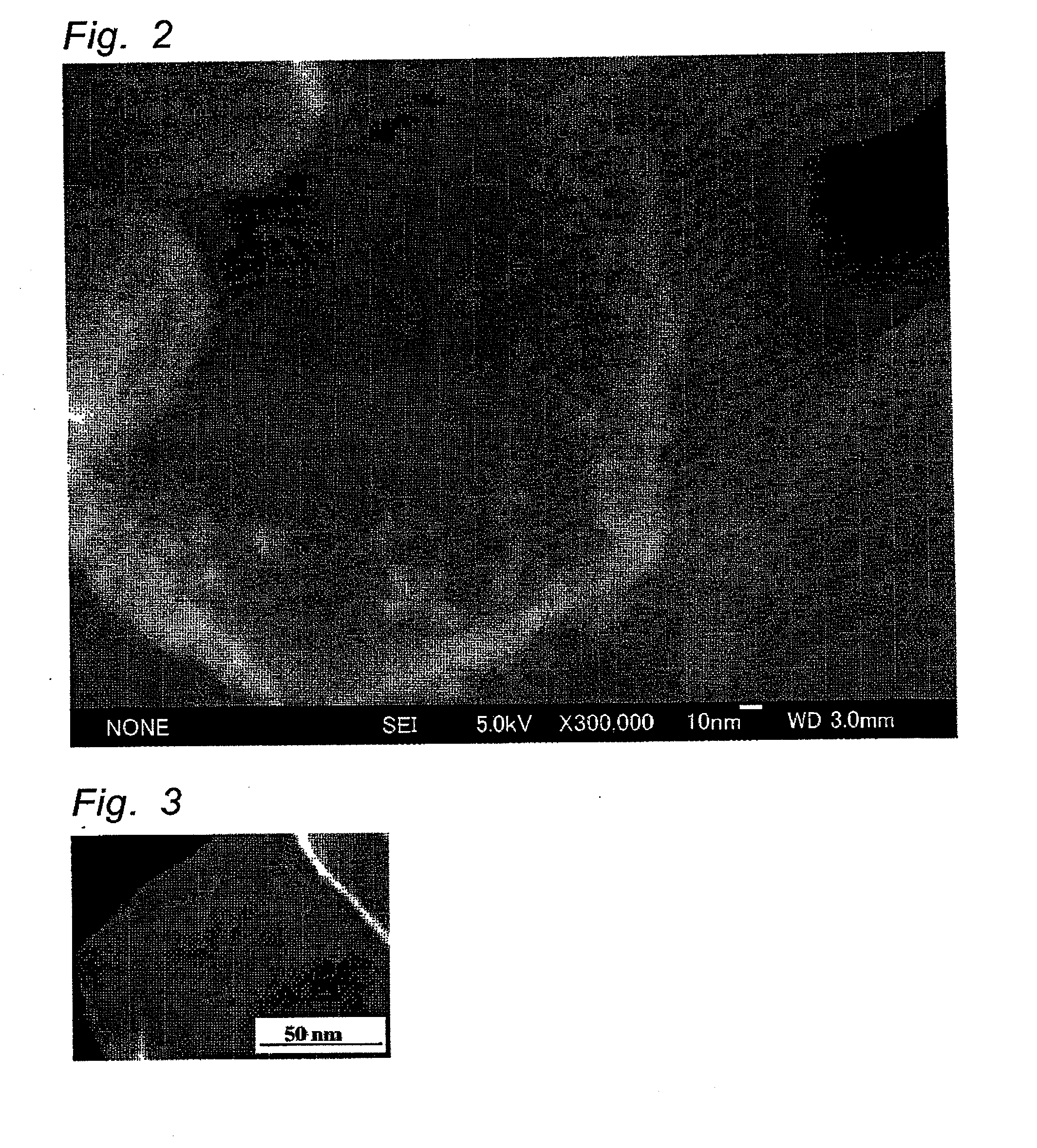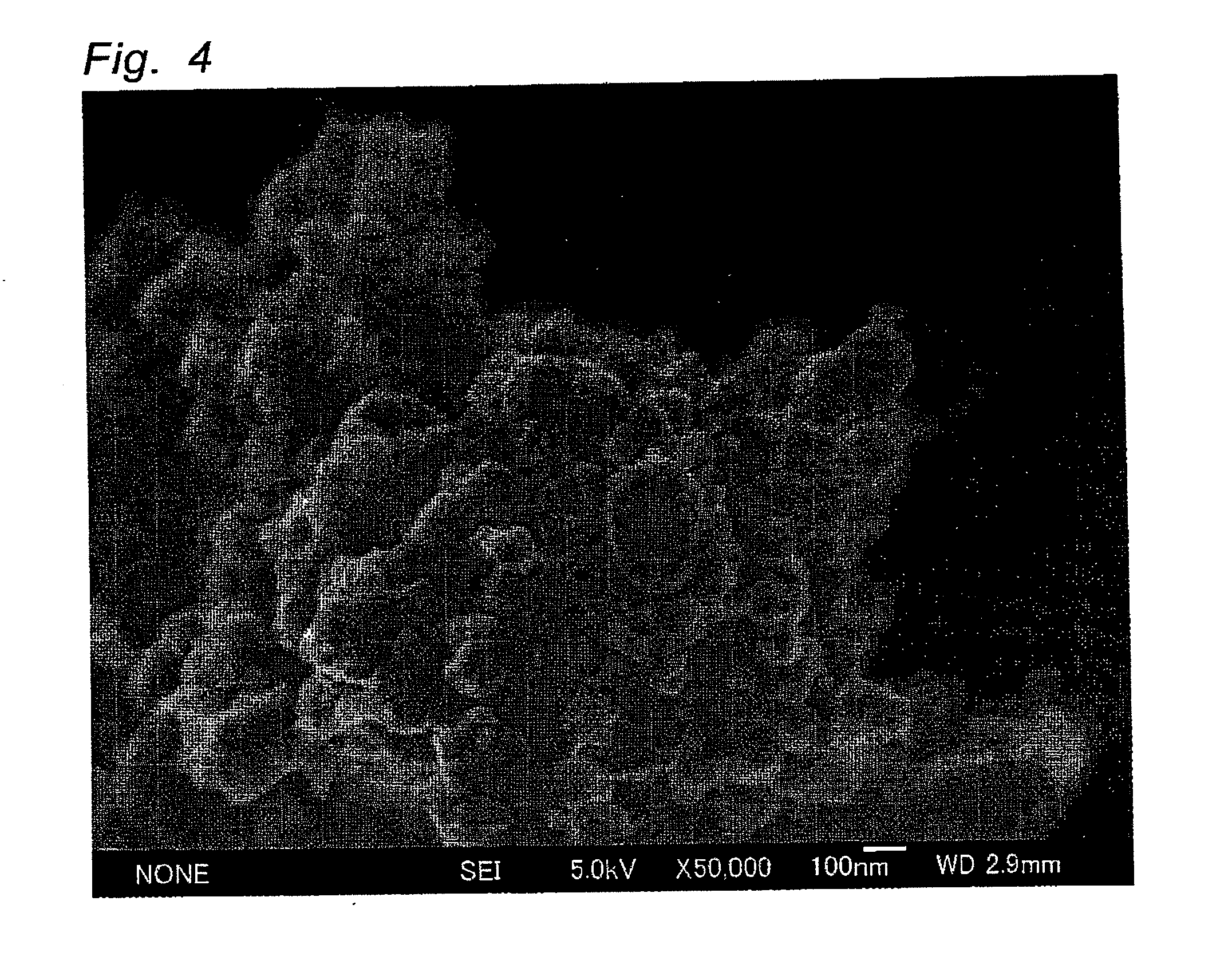Tungsten oxide photocatalyst
a photocatalyst and tungsten oxide technology, applied in the field of tungsten oxide photocatalysts, can solve the problems of insufficient photocatalytic activity, inability to reduce oxygen, and expensive equipment to prepare photocatalysts, etc., and achieve the effect of high photocatalytic activity
- Summary
- Abstract
- Description
- Claims
- Application Information
AI Technical Summary
Benefits of technology
Problems solved by technology
Method used
Image
Examples
example 1
[0052]Particle size distribution of a commercially available particulate tungsten oxide (WO3, purity 99.99%, manufactured by JAPAN PURE CHEMICAL CO., LTD.) was measured by a particle size distribution analyzer (manufactured by Shimadzu Corporation). As a result, D10, D50 and D90 were respectively 0.046 μm, 0.215 μm and 5.726 μm. Thus, D90 / D10 was 124. BET surface area was 6.0 m2 / g and thus a primary particle size was 140 nm.
[0053]4 g of tungsten oxide particles 4 g was dispersed in 50 mL of water and, after supersonic wave irradiation was carried out for 5 minutes, particles having a large particle size were sedimented and separated by a centrifugal separator (H-201F, manufactured by Kokusan Co., Ltd.) at a rotational speed of 1,000 rpm for 10 minutes. Particle distribution of particles dispersed in water was measured. As a result, D10, D50 and D90 were respectively 0.074 μm, 0.131 μm and 0.365 μm. Thus, D90 / D10 was 4.93. BET surface area was 8.5 m2 / g and thus a primary particle siz...
example 2
[0058]In the same manner as in Example 1, except that tungsten oxide particles sedimented by a centrifugal separator in Example 1 were used, a particulate Pt-supported tungsten oxide photocatalyst was obtained. Particle distribution of the resulting tungsten oxide particles was measured. As a result, D10, D50 and D90 were respectively 7.320 μm, 12.159 μm and 17.007 μm. Thus, D90 / D10 was 2.32. BET surface area was 4.8 M2 / g and thus the primary particle size was calculated at 175 nm. The surface of the resulting photocatalyst was observed by SEM. As a result, it was found that particles having a particle size of 10 to 20 nm are supported on the surface of tungsten oxide particles, similar to Example 1. Furthermore, the particles were observed by STEM-EDX. As a result, the particles are agglomerated particles composed of Pt particles having a primary particle size of 5 nm.
[0059]Using the resulting photocatalyst, the decomposition reaction of acetic acid was carried out under irradiatio...
example 3
[0060]In the same manner as in Example 1, except that the aqueous hexachloroplatinic acid solution was used so as to control the amount of Pt to 0.05 parts by weight based on 100 parts by weight of tungsten oxide particles, Pt-supported tungsten oxide particles were prepared. The surface of the resulting photocatalyst was observed by SEM. As a result, it was found that the same Pt particles having a particle size of 10 to 20 nm as in Example 1 are supported on the surface of tungsten oxide particles.
[0061]Using the resulting photocatalyst, the decomposition reaction of acotic acid was carried out under irradiation with visible light. As a result, the formation rate of carbon dioxide was 70 μmol / h.
[0062]Using the resulting photocatalyst, the decomposition reaction of acetaldehyde was carried out under irradiation with visible light. As a result, the amount of carbon dioxide formed during 0 to 30 minutes after the initiation of light irradiation was 10.6 μmol, the amount of carbon dio...
PUM
| Property | Measurement | Unit |
|---|---|---|
| particle size | aaaaa | aaaaa |
| particle size | aaaaa | aaaaa |
| particle size | aaaaa | aaaaa |
Abstract
Description
Claims
Application Information
 Login to View More
Login to View More - R&D
- Intellectual Property
- Life Sciences
- Materials
- Tech Scout
- Unparalleled Data Quality
- Higher Quality Content
- 60% Fewer Hallucinations
Browse by: Latest US Patents, China's latest patents, Technical Efficacy Thesaurus, Application Domain, Technology Topic, Popular Technical Reports.
© 2025 PatSnap. All rights reserved.Legal|Privacy policy|Modern Slavery Act Transparency Statement|Sitemap|About US| Contact US: help@patsnap.com



